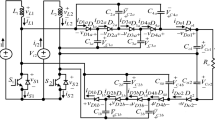Abstract
This paper proposes a new ultra-high step up converter by employing coupled inductor and interleaved techniques. Winding cross coupled inductors are utilized to enhance the conversion ratio and reduce the voltage stress of semiconductor components. Low voltage stress of switches makes it possible to use low on-resistance power switches. The conversion ratio of the proposed interleaved converter is extended by integrating with voltage lift circuits. The current flows into coupled inductors and the input current ripple is reduced because of the interleaved structure. The spike voltage of the switches is restricted by the clamp circuit. Main specifications of proposed interleaved converter are ultra-high voltage gain, low input current ripple, low voltage stress, low current stress, low core size, small volume, low reverse recovery loss of diodes, low conduction loss and high efficiency. The 18 V to 450 V prototype circuit is implemented at 100 W and its experimental results are presented which ascertains theoretical analysis.











Similar content being viewed by others
References
Lei H, Hao R, You X, Li F (2019) Nonisolated high step-up soft-switching DC–DC converter with interleaving and dickson switched-capacitor techniques. IEEE J Emerg Sel Top Power Electron 8(3):2007–2021. https://doi.org/10.1109/JESTPE.2019.2958316
Liu H, Hu H, Wu H, Xing Y, Batarseh I (2016) Overview of high-step-up coupled-inductor boost converters. IEEE J Emerg Sel Top Power Electron 4(2):689–704. https://doi.org/10.1109/JESTPE.2016.2532930
Zheng Y, Smedley KM (2019) Analysis and design of a single-switch high step-up coupled-inductor boost converter. IEEE Trans Power Electron 35(1):535–545. https://doi.org/10.1109/TPEL.2019.2915348
Zaoskoufis K, Tatakis EC (2020) An improved boost-based dc/dc converter with high-voltage step-up ratio for DC microgrids. IEEE J Emerg Sel Top Power Electron 9(2):1837–1853. https://doi.org/10.1109/JESTPE.2020.2981018
Tang J, Qi Z, Shan L, Ye W, Zhao C (2021) An innovative interleaved high step-up direct current–direct current converter with switched-inductor/capacitor–diode units for hydrogen fuel cell power system. Int J Circuit Theory Appl. https://doi.org/10.1002/cta.3082
Sabahi M, Tarzamni H, Kolahian P (2021) Operation and design analysis of an interleaved high step-up DC–DC converter with improved harnessing of magnetic energy. Int J Circuit Theory Appl 49(2):221–243. https://doi.org/10.1002/cta.2913
Zheng Y, Xie W, Smedley KM (2019) A family of interleaved high step-up converters with diode–capacitor technique. IEEE J Emerg Sel Top Power Electron 8(2):1560–1570. https://doi.org/10.1109/JESTPE.2019.2907691
Zheng Y, Brown B, Xie W, Li S, Smedley K (2020) High step-up DC–DC converter with zero voltage switching and low input current ripple. IEEE Trans Power Electron 35(9):9416–9429. https://doi.org/10.1109/TPEL.2020.2968613
Jalilzadeh T, Babaei E, Maalandish M (2018) Generalized nonisolated high step-up DC–DC converter with reduced voltage stress on devices. Int J Circuit Theory Appl 46(11):2053–2078
Fani R, Farshidi E, Adib E, Kosarian A (2019) Analysis and implementation of high step-up DC/DC convertor with modified super-lift technique. J Power Electron 19(3):645–654
Majarshin AR, Babaei E (2019) High step-up DC–DC converter with reduced voltage and current stress of elements. IET Power Electron 12(11):2884–2894
Ye Y, Cheng KWE, Chen S (2016) A high step-up PWM DC–DC converter with coupled-inductor and resonant switched-capacitor. IEEE Trans Power Electron 32(10):7739–7749
Ye Y, Chen S, Yi Y (2020) Switched-Capacitor and coupled-inductor-based high step-up converter with improved voltage gain. IEEE J Emerg Sel Top Power Electron 9(1):754–764. https://doi.org/10.1109/JESTPE.2020.2971525
Shaneh M, Niroomand M, Adib E (2018) Ultrahigh-step-up nonisolated interleaved boost converter. IEEE J Emerg Sel Top Power Electron 8(3):2747–2758. https://doi.org/10.1109/JESTPE.2018.2884960
Premkumar M, Kumar C, Anbarasan A, Sowmya R (2020) A novel non-isolated high step-up DC–DC boost converter using single switch for renewable energy systems. Electr Eng 1–19
Samuel VJ, Keerthi G, Mahalingam P (2020) Interleaved quadratic boost DC–DC converter with high voltage gain capability. Electr Eng 102(2):651–662
Fani R, Farshidi E, Adib E, Kosarian A (2019) Analysis, design, and implementation of a ZVT high step-up DC–DC converter with continuous input current. IEEE Trans Ind Electron 67(12):10455–10463. https://doi.org/10.1109/TIE.2019.2960727
Li W, He X (2008) A family of interleaved DC–DC converters deduced from a basic cell with winding-cross-coupled inductors (WCCIs) for high step-up or step-down conversions. IEEE Trans Power Electron 23(4):1791–1801
Li W, Zhao Y, Wu J, He X (2009) Interleaved high step-up converter with winding-cross-coupled inductors and voltage multiplier cells. IEEE Trans Power Electron 27(1):133–143. https://doi.org/10.1109/TPEL.2009.2028688
Fani R, Farshidi E, Adib E, Kosarian A (2020) Interleaved non-isolated DC–DC converter for ultra-high step-up applications. IET Power Electron 13(18):4261–4269
Moradisizkoohi H, Elsayad N, Mohammed OA (2019) An integrated interleaved ultrahigh step-up dc–dc converter using dual cross-coupled inductors with built-in input current balancing for electric vehicles. IEEE J Emerg Sel Top Power Electron 8(1):644–657. https://doi.org/10.1109/JESTPE.2019.2943301
Akhlaghi B, Molavi N, Fekri M, Farzanehfard H (2017) High step-up interleaved ZVT converter with low voltage stress and automatic current sharing. IEEE Trans Ind Electron 65(1):291–299
Zheng Y, Xie W, Smedley KM (2018) Interleaved high step-up converter with coupled inductors. IEEE Trans Power Electron 34(7):6478–6488
Muhammad M, Armstrong M, Elgendy MA (2015) A nonisolated interleaved boost converter for high-voltage gain applications. IEEE J Emerg Sel Top Power Electron 4(2):352–362
Author information
Authors and Affiliations
Corresponding author
Additional information
Publisher's Note
Springer Nature remains neutral with regard to jurisdictional claims in published maps and institutional affiliations.
Rights and permissions
About this article
Cite this article
Fani, R., Erfani Majd, N. An interleaved ultra-high step up DC–DC converter with low voltage stress. Electr Eng 104, 3649–3657 (2022). https://doi.org/10.1007/s00202-022-01563-y
Received:
Accepted:
Published:
Issue Date:
DOI: https://doi.org/10.1007/s00202-022-01563-y




